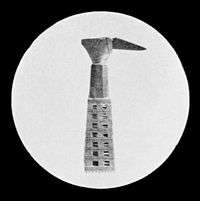Sennit
Sennit is a type of cordage made by plaiting strands of dried fibre or grass. It can be used ornamentally in crafts, like a kind of macrame, or to make straw hats. Sennit is an important material in the cultures of Oceania, where it is used in traditional architecture, boat building, fishing and as an ornamentation.[1]
Oceania

Tonga
Sennit in Tonga is called kafa.
Fiji
Sennit is the western term used for magimagi, an exclusive craft product of the Fiji Islands. Only Fijian artists know how to weave the beauty of magimagi into the traditional Fijian look.
Hawai'i
The term is also used in Hawaii and throughout Polynesia for cordage made by braiding the fibers of coconut husks. It was important in attaching the ʻama (outrigger float) via the iako (spars) to the hull of canoes, stones to war-club handles, erecting hale (houses), etc.
Samoa
In the Samoan language, sennit is called ʻafa. It was used as cordage in the construction of traditional Samoan architecture, boat building with many other functional uses. ʻAfa is handmade from dried coconut fibre from the husk of certain varieties of coconuts with long fibres, particularly the niu'afa (afa palm).[2]
Sennit is mentioned in Robert Gibbings book Over the Reefs (1948).[3] He refers to its use in Samoa in 1946, where he was able to observe its being made on many occasions. He notes that its crafting was a constant occupation in Samoan villages, because so much of the material was required. A significant quote from the book, made by a village chief to Gibbings, emphasises the importance of sennit in Samoan culture: "In your country," said a chief to me, "only a few men can make nails, but in Samoa, everyone can make nails." (p. 118) He was referring to the sennit that is used to bind the structures or huts in which they lived. Sennit had a variety of other uses, including in shark fishing, where it was used as a noose that was placed over the shark's head as it came alongside the canoe.
"They showed me the sennit noose they had used - five years old and as good as new. They said it would last another five years if cared for." Robert Gribbings.
See also
References
- ↑ Hiroa, Te Rangi (1964). Vikings of the Sunrise. New Zealand: Whitecombe and Tombs Ltd. p. 27. Retrieved 21 August 2010.
- ↑ Grattan, F.J.H. (1985). An Introduction to Samoan Custom. New Zealand: R. McMillan. pp. 164, 165. ISBN 0-908712-13-8. Retrieved 14 August 2010.
- ↑ "Over the Reefs", J.M. Dent & Sons Ltd., London, 1948.

